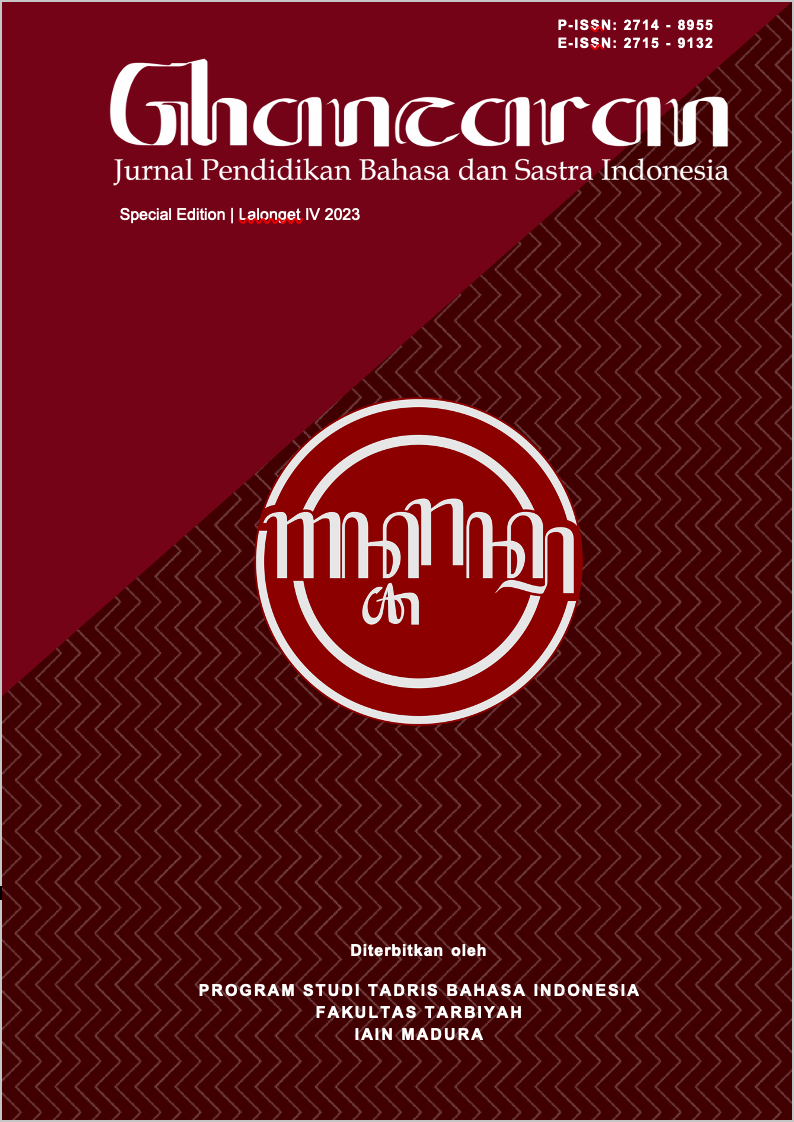Bookcreator Bermuatan Kearifan Lokal sebagai Media Penguatan Literasi Baca Digital
 Abstract views: 170
,
Abstract views: 170
,
 PDF downloads: 163
PDF downloads: 163
Abstract
Read literacy is not just reading but needs to be connected with technology and local wisdom to be in line with the demands of the times. The aim of this research is to describe strengthening digital literacy through bookcreators containing local wisdom in elementary schools. Data was collected through observation, questionnaire interviews and tests. Instrumens include interview sheets, observation sheets, questionnaires and description questions. The students who were the research subjects were 4th grade students at the Josenan 1 elementary school in Madiun City with a total of 25 students. The results of the research show that students are enthusiastic about telling stories about local wisdom, enjoy reading bookcreators and the test results for making concept maps of main ideas and supporting ideas received a score of 3.57 in terms of accuracy, neatness and time. Student activities in strengthening reading literacy need to be carried out every day to familiarize students with literacy. It is hoped that the local wisdom contained in the bookcreator can make students understand and appreciate the local culture around them
Downloads
References
Anggito, A., & Setiawan, J. (2018). Metodologi penelitian kualitatif. CV Jejak (Jejak Publisher).
Arikunto, S. (2008). Dasar-dasar evaluasi pendidikan edisi kedelapan. Jakarta: Bumi Aksara.
Aufderheide, P. (2018). Media literacy: From a report of the national leadership conference on media literacy. In Media Literacy Around the World (pp. 79–86). Routledge.
Baran, E., Canbazoglu Bilici, S., Albayrak Sari, A., & Tondeur, J. (2019). Investigating the impact of teacher education strategies on preservice teachers’ TPACK. British Journal of Educational Technology, 50(1), 357–370.
Bawden, D. (2001). Information and digital literacies: a review of concepts. Journal of Documentation, 57(2), 218–259.
Bawden, D. (2008). Origins and concepts of digital literacy. Digital Literacies: Concepts, Policies and Practices, 30(2008), 17–32.
Cahyani, H., & Cahyono, B. Y. (2012). Teachers’attitudes And Technology Use In Indonesian Efl Classrooms. Teflin Journal, 23(2), 130.
Dewi, W. A. F. (2020). Dampak Covid-19 terhadap implementasi pembelajaran daring di Sekolah Dasar. Edukatif: Jurnal Ilmu Pendidikan, 2(1), 55–61.
Gilster, P. (1997). Digital Literacy. New York: Wiley&Sons. Inc.
Hidayat, A., & Prasetya, E. R. (2020). Penerapan teknologi dalam analisis perilaku belajar reflektif berbasis sistem android untuk meningkatkan pembelajaran e-learning. Gammath: Jurnal Ilmiah Program Studi Pendidikan Matematika, 4(2), 79–87.
Kissau, S. (2015). Type of instructional delivery and second language teacher candidate performance: Online versus face-to-face. Computer Assisted Language Learning, 28(6), 513–531.
Kramsch, C. (2003). Teaching language along the cultural faultline. Culture as the Core: Perspectives on Culture in Second Language Learning, 19–35.
Maftuchah, R., Hartatik, S., Amin, S. M., & Susanto, R. U. (2023). Perbedaan Hasil Pretest dan Posttest terhadap Hasil Belajar Materi Cerita Pendek Menggunakan Media Book Creator pada Siswa Kelas IV SDN Putat Jaya II/378 Surabaya. Jurnal Pendidikan Tambusai, 7(2), 12314–12318.
Oktawirawan, D. H. (2020). Faktor pemicu kecemasan siswa dalam melakukan pembelajaran daring di masa pandemi covid-19. Jurnal Ilmiah Universitas Batanghari Jambi, 20(2), 541–544.
Palupi, D. A. R., Putri, K. E., & Mukmin, B. A. (2022). Pengembangan E-book menggunakan Aplikasi Bookcreator berbasis QR Code pada Materi Ajar Siswa Sekolah Dasar. PTK: Jurnal Tindakan Kelas, 3(1), 78–90.
Puspitasari, V., Rufi’i, & Walujo, D. A. (2020). Pengembangan Perangka Pembelajaran dengan Model Doferensiasi Menggunakan Book Creator untuk Pembelajaran BIPA di Kelas yang Memiliki Kemampuan Beragam. Jurnal Education and Development Institut, 8(4), 310–319.
Rahyono, F. X. (2015). Bahasa lokal sebagai representamen ilmu pengetahuan. Tutur: Cakrawala Kajian Bahasa-Bahasa Nusantara, 1(1), 1–10.
Rassool, N. (1999). Literacy for sustainable development in the age of information (Vol. 14). Multilingual matters.
Samsiyah, N., & Suryo, E. 2021. Habituation Of Title Literation In Empowering Reading Interest In Students Of State 01 Pandean Madiun. Jurnal Handayani Pgsd Fip Unimed, 10(2), 68–72.
Sugiyono. (2013). Metode Penelitian Pendidikan (Pendekatan Kuantitatif, Kualitatif, dan R&D. Alfabeta.
Sutiarini, S., & Yuntina, L. (2023). Pengembangan Buku Cerita Tema Hewan dengan Aplikasi Book Creator Untuk Meningkatkan Kognitif Anak Kelompok B di TKIT Nurul Ilmi Bekasi. Jurnal Pendidikan Tambusai, 7(3), 21060–21066.
Copyright (c) 2023 GHANCARAN: Jurnal Pendidikan Bahasa dan Sastra Indonesia

This work is licensed under a Creative Commons Attribution-ShareAlike 4.0 International License.
Ghancaran: Jurnal Pendidikan Bahasa dan Sastra Indonesia uses an Open Access Policy under the Creative Commons Attribution-ShareAlike 4.0 International License. Authors publishing in this journal agree to the following terms:
- Ghancaran Journal holds the copyright and grants the journal rights for first publication with the work simultaneously licensed under a

The work is distributed under Creative Commons Attribution-ShareAlike 4.0 International License which allows others to share, copy, and redistribute the material in any media or format and adapt, remix, change, and develop the material even for commercial purposes, as long as it is stated credit and license derivative works under similar terms. - Authors may make additional contractual arrangements for non-exclusive distribution of the journal's published work version.
- Authors are permitted to post their work online (e.g., in institutional repositories or on their websites) before and during submission, as doing so may lead to productive exchange.



















